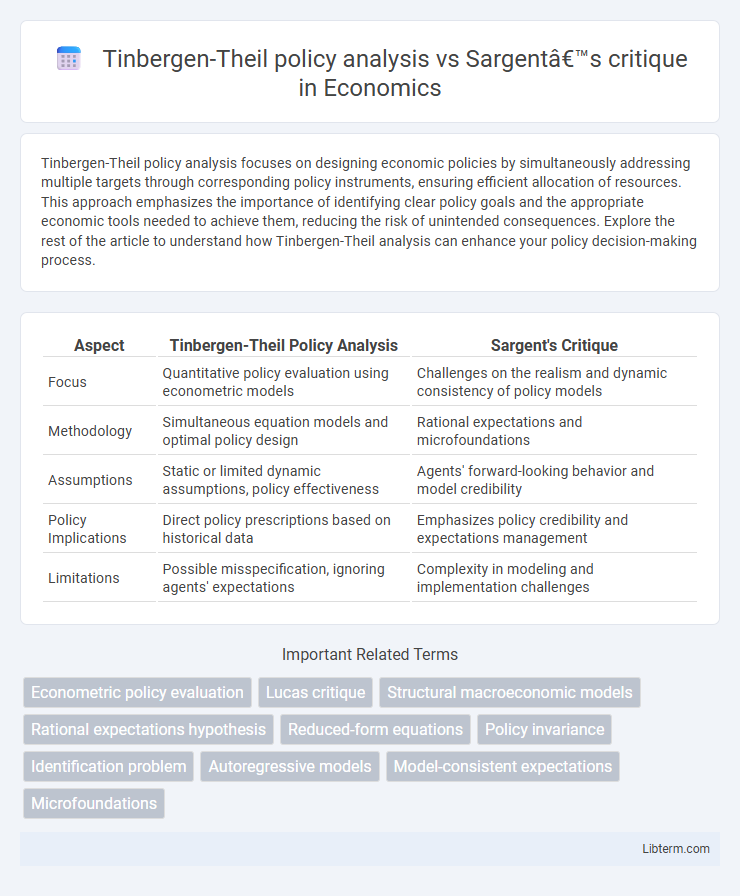Tinbergen-Theil policy analysis focuses on designing economic policies by simultaneously addressing multiple targets through corresponding policy instruments, ensuring efficient allocation of resources. This approach emphasizes the importance of identifying clear policy goals and the appropriate economic tools needed to achieve them, reducing the risk of unintended consequences. Explore the rest of the article to understand how Tinbergen-Theil analysis can enhance your policy decision-making process.
Table of Comparison
| Aspect | Tinbergen-Theil Policy Analysis | Sargent's Critique |
|---|---|---|
| Focus | Quantitative policy evaluation using econometric models | Challenges on the realism and dynamic consistency of policy models |
| Methodology | Simultaneous equation models and optimal policy design | Rational expectations and microfoundations |
| Assumptions | Static or limited dynamic assumptions, policy effectiveness | Agents' forward-looking behavior and model credibility |
| Policy Implications | Direct policy prescriptions based on historical data | Emphasizes policy credibility and expectations management |
| Limitations | Possible misspecification, ignoring agents' expectations | Complexity in modeling and implementation challenges |
Introduction to Macroeconomic Policy Analysis
Tinbergen-Theil policy analysis emphasizes identifying specific policy instruments to achieve targeted economic goals based on a structural macroeconomic model. Sargent's critique challenges this approach by questioning the stability and identification of such models under rational expectations, arguing that agents' anticipations alter policy effectiveness and invalidate traditional policy prescriptions. This debate significantly influenced the evolution of macroeconomic policy analysis, steering it towards incorporating expectations and microfoundations for credible policy evaluation.
Overview of Tinbergen-Theil Approach
The Tinbergen-Theil approach to policy analysis emphasizes the use of econometric models to determine optimal policy instruments by establishing quantitative relationships between target variables and policy tools. This methodology relies on precise economic modeling and parameter estimation to achieve policy targets effectively within given constraints. Sargent's critique challenges the approach by highlighting issues of model misspecification and the unrealistic assumption of stable policy parameters in dynamic, forward-looking economies.
The Mechanisms Behind Tinbergen-Theil Models
Tinbergen-Theil policy analysis relies on simultaneous equation models to represent economic mechanisms, emphasizing the identification of structural parameters to inform policy decisions. The framework assumes stable relationships between endogenous and exogenous variables, enabling precise policy intervention analysis through econometric estimation. Sargent's critique challenges this by highlighting model misspecification risks and the neglect of agents' rational expectations, which can undermine the validity of policy prescriptions derived from Tinbergen-Theil models.
Policy Effectiveness in the Tinbergen-Theil Framework
The Tinbergen-Theil policy analysis framework emphasizes the simultaneous use of multiple policy instruments to achieve distinct economic targets, asserting policy effectiveness through precise instrument-target matching and system identification. Sargent's critique challenges this view by highlighting the importance of agents' expectations and adaptive behavior, arguing that policy effectiveness may diminish as rational actors anticipate policy actions, leading to time inconsistency and dynamic inefficiencies. Consequently, Sargent calls for models incorporating rational expectations and forward-looking behavior, which reveal limitations in the Tinbergen-Theil framework's static assumptions about policy effectiveness.
Sargent’s Critique: The Rational Expectations Revolution
Sargent's critique of Tinbergen-Theil policy analysis centers on the introduction of the Rational Expectations Revolution, which argues that traditional econometric models fail to account for how agents anticipate policy changes and adjust their behavior accordingly. He asserts that policy effectiveness predicted by Tinbergen-Theil models is often overstated because these models do not incorporate forward-looking expectations, leading to systematic policy ineffectiveness. Sargent's work emphasizes that credible and anticipated policy interventions are neutralized by agents' rational responses, fundamentally challenging the predictive power of earlier structural policy analyses.
Key Differences: Tinbergen-Theil vs. Sargent’s Perspective
Tinbergen-Theil policy analysis emphasizes the identification of policy targets and instruments through formal econometric models to achieve optimal policy settings, relying heavily on structural assumptions and equilibrium conditions. Sargent's critique challenges these assumptions by arguing that rational expectations and adaptive learning significantly alter policy effectiveness, highlighting model misspecification and the potential for dynamic inconsistency. The key difference lies in Tinbergen-Theil's focus on static optimization versus Sargent's emphasis on expectations formation and the time consistency of policy rules.
The Lucas Critique and Its Impact on Policy Modeling
The Lucas Critique, introduced by Robert Lucas, challenged traditional Tinbergen-Theil policy analysis models by arguing that policy parameters estimated from historical data become unreliable when policies change, as agents adjust their expectations and behaviors. Sargent's critique further emphasized the need for models incorporating rational expectations and microfoundations to accurately predict policy impacts. This shift led to the development of dynamic stochastic general equilibrium (DSGE) models, fundamentally transforming empirical policy modeling and forecasting methodologies.
Empirical Implications for Economic Policy
Tinbergen-Theil policy analysis emphasizes the identification of controllable economic targets through simultaneous equation models, providing clear empirical implications for optimal policy design. Sargent's critique highlights the limitations of this approach by stressing the importance of rational expectations and model consistency, arguing that policy effectiveness cannot be accurately predicted without accounting for agents' forward-looking behavior. Empirical implications from Sargent's perspective suggest that policies based solely on Tinbergen-Theil methods risk ineffectiveness or unintended consequences due to neglecting the adaptive responses of economic agents.
Relevance of Policy Analysis Methods Today
Tinbergen-Theil policy analysis emphasizes quantitative modeling and optimal policy design, prioritizing empirical data and econometric methods to guide decision-making. Sargent's critique highlights the limitations of these models, particularly their sensitivity to assumptions and difficulties in capturing rational expectations and dynamic behaviors in economic agents. Today, integrating robust empirical techniques with models that account for agent expectations remains crucial for relevant and effective policy analysis.
Conclusion: Evolving Approaches in Macroeconomic Policy
Tinbergen-Theil policy analysis emphasizes the identification of precise economic targets and corresponding instruments to achieve optimal macroeconomic outcomes. Sargent's critique highlights the limitations of this framework, stressing the importance of expectations, rational behavior, and the dynamic nature of policy effects in macroeconomic modeling. The evolution of macroeconomic policy increasingly integrates these insights, combining rule-based approaches with adaptive expectations to enhance the credibility and effectiveness of economic interventions.
Tinbergen-Theil policy analysis Infographic

 libterm.com
libterm.com